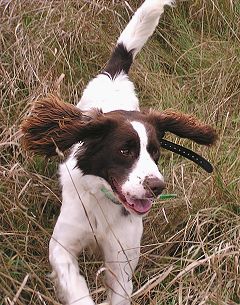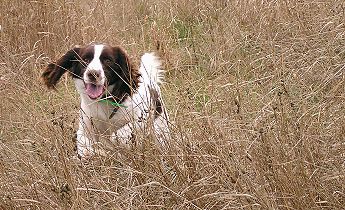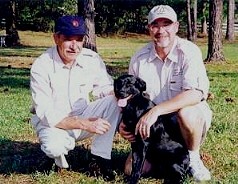  When I first started using the electronic remote trainer to help me train my dogs, I was taught to use continuous stimulation. However, after the initial level finding and basic introduction to the collar, I find that more and more I am using momentary stimulation in the training of my dogs.
Momentary stimulation has many advantages in the training of dogs. Advantages, which owners not only need to be aware of to help them in their training, but will also give them the opportunity to use a form of stimulation to fine tune their dogs while maintaining style and drive.
Think of the ‘tap’ as an attention getter - "Hey! listen to me." Like you would touch someone on the shoulder when you want them to hear what you have to say. Sometimes, when they are relaxed completely, it only has to be a light tap. Other times, when they are mildly concentrating on something else, it is a slightly harder tap… and sometimes when they are totally focused on a subject it has to be a hard tap. The feeling to the person you are tapping will probably be about the same - although it varies in intensity because of their thought and concentration processes at the time.
Most quality remote trainers now provide both continuous and momentary stimulation. This allows the trainer to develop and use the best approach to training a dog. The best way will always bring out the natural abilities and skills of the dog, the desire to please, and maintain style and performance while providing the control and reinforcement of actions in a humane way.
Many trainers have limited their use of momentary stimulation. Often, this is due to insufficient experience and knowledge of its application. We are educated into the use of a specific method and we do not take it any further. Few of us experiment.
"It diverts his focus from what he was doing or wanting to do, and places his concentration on the trainer and what he wants the dog to do."
Momentary stimulation was developed mainly for pointing dogs. Today, however, I use it on all breeds. It is especially useful for steadying to the flush and retrieving. The original concept of using momentary was to maintain the point and ‘whoa’ command, and create steadiness while still retaining the style, which is so essential in bird dogs. This momentary can be also used to sit the dog after a good flush by a spaniel, reinforcing at a level which communicates but does not provide an aversive which could have the dog ignoring a bird.
Low momentary provides a stimulation for a split second - often one, one thousandth of a second, just a single pulse - much faster than anyone could ever tap a button on continuous. This pulse has an attention getting affect, a ‘tap’. Touch it yourself and experience the single ‘tap’ from this and you will notice something quite fascinating. It is so quick that at low levels it is almost unnoticeable, maybe even subliminal. At medium range levels, it comes and goes so quickly it is virtually painless. It has a startling effect but because it happens so quickly and for such a short duration it does not overload the nerve endings. Touch an electric fence or other forms of electric stimulation and you will be left rubbing the ‘touched’ spot because the nerve endings have been overloaded. This does not happen with momentary at any setting. There are no residual sensations from the stimulation. For bird dogs this gave trainers the ability to hold the dog on point without creating any aversion to the game it was pointing. It provides the average dog owner the opportunity to correct a dog around game without overdoing it in such a way that the dog could ‘blink’ or even avoid game.
When I began using momentary just over seven years ago for training retrievers and spaniels, I quickly realized the advantages, its versatility and more forgiving application. I began to use it more for specific situations in combination with continuous; momentary for a tap - a reminder - and continuous for the introduction to the collar or a major misdemeanor such as chasing. In fact, very quickly I found that I could use a number of taps on momentary to stop chasing also.
"Any dog we are training should feel that it has the right to make a mistake without being over corrected for it."
Most models these days provide the ability to adjust levels from the hand held transmitter as well as change from momentary to continuous. This is a major step forward in the ability of the trainer to select exactly the right level at the moment it is required. My own personal choice is the Tritronics PRO 500XLS and all my comments in this article relate to this unit.
Momentary, because of its duration, often needs a higher-level setting than continuous to be perceived by the dog. Therefore, once the right level of continuous has been found for the dog and the type of training being done, in most cases, it is necessary to step up one level on the switch, for the dog to feel it. Although continuous stimulation is the main ‘vehicle’ for introducing the dog to the collar through the classic escape and avoidance routine; apply continuous, guide the dog into the action required and then stop applying stimulation as action occurs - momentary can also be used effectively in early training. Using momentary, give the command and at the same time give a single pulse stimulation – a tap - while guiding the dog into the action required.
In both approaches, many recommend that the dog should already have been taught the commands prior to application of the collar. However, I personally have found that through guiding using a leash or a long line and the application of momentary stimulation you can speed the learning process even though a dog has not been taught the command. You are actually teaching not reinforcing through the use of the collar. The momentary tap is prompting the dog like a light tap on the butt for a sit.
The use of the e-collar starts with yard work. After finding the level with continuous and obtaining a good recall using it, I generally go up one level and begin to use momentary to prompt the command. The sit and the recall are the two most important commands the collar can help you with - so concentrate on these.
In the field when hunting a dog, the tap can reinforce the turn. Using the turn whistle, tap momentary simultaneous with the command and repeat the tap… until the dog complies. On some occasions, you may have to give the command again - especially if you have waited longer than two seconds after a previous command or ‘tap’ of momentary.
At this stage, your dog will have been taught the recall command and the turn whistle is a shortened version of this - so he should turn towards you where you can bring him in and then cast him in the opposite direction. In this instance, the use of the collar is to reinforce, speed up and polish.
With momentary, the speed of the stimulation is such that it is an attention grabber - a diverter of the mind from the wrong intention of the dog. It diverts his focus from what he was doing or wanting to do, and places his concentration on the trainer and what he wants the dog to do. That is the finesse of momentary and its main advantage. It gets attention without putting your dog’s brain into confusion and even panic. Through correct usage, a trainer can select just the right intensity of ‘tap’ to gain the dog’s attention and willingness to do what is required without impairing its ability to focus and ability to think. It acts as a focus diverter, redirector, changer - or mind splitter.
This momentary prompt can also be used on the recall even when the dog is carrying a retrieve. In this situation, I will step down a level so that the dog feels the tap but does not startle or think that the tap is because he is carrying a bird. I also will use this level in water. It is often claimed that water does not affect the feel of the stimulation. However, my experience is that it does. I believe what happens is that the skin softens in water and the skin tissue resistance is lessened making the stimulation feel higher.
Momentary can also be easily used as a distracter and controller before a strong focus is established which would make it difficult to control the dog. It is an attention grabber, "Hey! listen to me," or a warning, "Don’t even think of it!" Again, so quick and non-invasive to the dogs mind that it does not create problems with their thinking.
Take, for example, a dog that sees a deer ahead. With momentary it is so easy to ‘remind’ the dog before a chase really sets in. By tapping the button and giving the command ‘sit’ you have minimized or even eliminated the chasing and replaced the chase action with the more acceptable one of sitting. Exactly the same as with the flushing dog or retriever at heel, we can replace the potential chase that can follow with a ‘sit’ and watch the birds fly away. Watch any dog that is sitting or standing and just before it breaks, notice its muscles tense up and the slight forward movement. By timing a low momentary pulse, we can stop the breaking sequence well before the dog is in full chase. This is much more subtle and far better on the dog, when done correctly, than a harsh correction when the dog is in full flight after a bird. If the dog has been properly schooled on sit, that one ‘tap’ is enough to stop it completely. Just one tap. With flushing dogs, I wait until a split second after the flush and then ‘tap’ the dog giving him the ‘sit’ whistle at the same time. Previous to this he will have been taught the ‘sit’ whistle reinforced with the tap, and also when first teaching steadiness I will have a long line on him to show him through physical restraint what is required in addition to the e-collar.
"When in doubt - don’t press the button."
A trainer can finesse things so much more with momentary. However, just because momentary is merely a ‘tap’ you should not overuse it. Any dog we are training should feel that it has the right to make a mistake without being over corrected for it. We don’t press a button every time an error occurs because we do not know exactly what is in that dog’s mind. We like to see a little trend happening and give the dog the benefit of the doubt. You have to learn from and understand your dog by allowing it to make mistakes. Often, it is not their mistake - but rather it is a lack of training on your part. If you apply stimulation incorrectly to a confused dog and attempt to force him through the situation all you get is a more confused dog. If, during training, we put our dog in a position where it can do right and avoid eventualities where it can go wrong we can build the foundations of a well-trained dog and minimize corrections.
A solid correction should only be given when you know the dog understands a command. When a problem occurs ask yourself, "Is it me? Is it the situation? Have we progressed the training too quickly - or is it the dog?" Get to know why a dog does what it does. Be able to read your dog – it’s body language often shouts. Once you can really read your dog and you know he is willfully disobeying then you can correct with the collar. Always believe that the dog is trying to do his best for you unless he proves differently. Although we want to avoid any errors on the part of the trainer, an error with momentary is a very short error and will not affect the dog to the same degree as an error with continuous. When in doubt - don’t press the button.
The most common question I am asked at my workshops and seminars is how we ensure the dog does not become collar wise. The answer is easy; he wears it every time he is out of his kennel or crate and especially when he is training. After a while you will be using the collar less and less as you impart training and all the good habits. When you no longer or extremely rarely have to tap him then you know he is behaving naturally and not doing anything because he has a collar attached. I do not recommend trying out his behavior without the collar at any time until he is consistent in what he does. Even if you are rarely using it in training, it is not doing any harm being there. It is like an insurance policy, you may never need it but it is there should you ever require it.
I have found that momentary stimulation is similar to a tap on the shoulder. It is a, "Hey, remember me? Remember what I am asking you?" Try it, getting confidence in its application. I have found that it sharpens up a dogs performance without loosing the essential drive and style that makes working a hunting dog such a joy. I have used it many times on spaniels - both cockers and springers - and by using it correctly, found no loss of drive or style.

|
|
|
| Bookstore | The Bookshelf | Advertise on SJ | Classifieds | Resources | NEW! Events | Letters | Archives | Spaniel Journal | |


